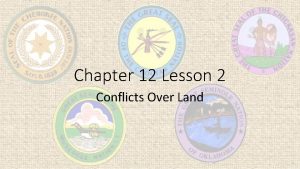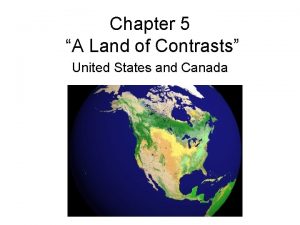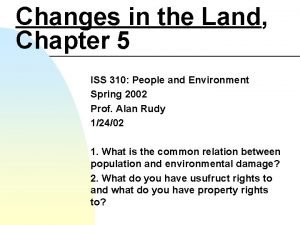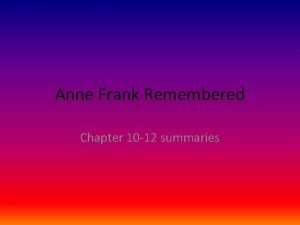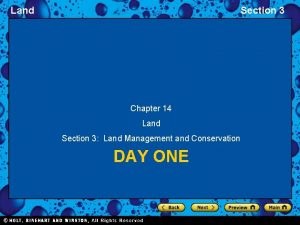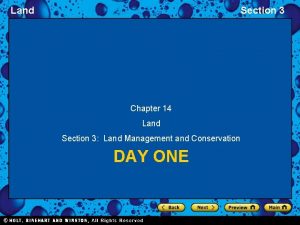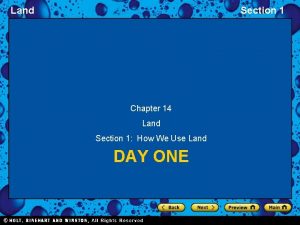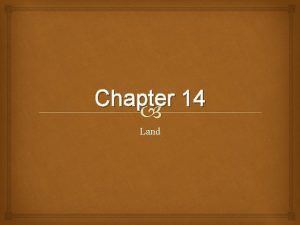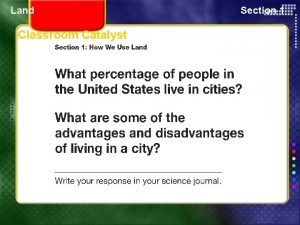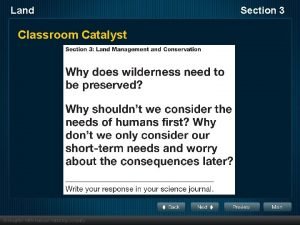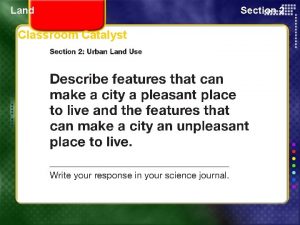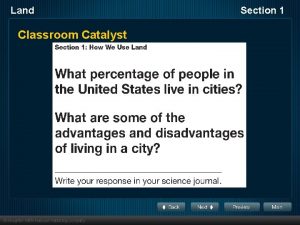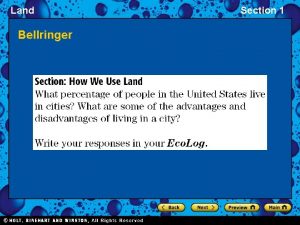Land Section 1 Chapter 14 Land Section 1












- Slides: 12

Land Section 1 Chapter 14 Land Section 1: How We Use Land DAY ONE

Land Section 1 Land Use and Land Cover • We use land for many purposes, including farming, mining, building cities and highways, and recreation. • Land cover is what you find on a patch of land, and it often depends on how the land is used. – For example, land cover might be a forest, a field of grain, or a parking lot. • There are different types of land cover and different human uses for each cover type.

Land Section 1 Land Use and Land Cover

Land Section 1 Land Use and Land Cover • Urban describes an area that contains a city, or an area that contains 2, 500 or more people and usually has a governing body, such as a city council. • Rural describes an area of open land that is often used for farming, or any population not classified as urban. • Most land provides one or more resources that humans consume. – wood in forests – crops in farmland – mineral resources

Land Section 1 Where We Live • Until about 1850, most people lived in rural areas. • Many of them were farmers, who grew crops and raised livestock. – Others managed the forests, worked in local mines or mills, or manufactured the necessities of life for the town. • The Industrial Revolution changed this pattern as machinery made it possible for fewer people to operate a farm or grain mill and better transportation allowed manufacturers to be located farther from their customers.

Land Section 1 Where We Live • Thousands of rural jobs were eliminated, and many people had to move to cities to find jobs. • As a result, urban areas grew rapidly during the 20 th century and spread over more land. • The movement of people from rural to urban areas happened in developed countries between about 1880 and 1950. Now, this movement is occurring rapidly in developing countries.

Land Section 1 Where We Live • Today, most people throughout the world live in urban areas.

Land Section 1 The Urban-Rural Connection • Whether people live in cities or in the countryside, people are dependent on resources produced in rural areas. • These resources include: – clean drinking water – fertile soil – land for crops – trees for wood and paper – much of the oxygen we breath, which is produced by plants. • An ecosystem service is the role that organisms play in creating a healthful environment for humans.

Land The Urban-Rural Connection Section 1

Land Section 1 Supporting Urban Areas • The area of rural land needed to support one person depends on many factors – the climate – the standard of living – how efficiently resources are used • Each person in a developed country uses the ecosystem services provided by about 8 hectares of land. – But, many people in developing countries do not have access to all the resources for a healthy life, and may use ecosystem services from less than a hectare of land person.

Land Section 1 Land Use and Land Coverage

Land Section 1 Ticket out the Door 1. List three reasons why we use land. 2. List two resources humans use from land. 3. What portion of history changed from where we used to live (rural land) to why we live in the urban areas now? 4. List three resources that make up the urban rural connection. 5. List two factors that support one person who resides on a piece of rural land.
 Chapter 14 land section 1
Chapter 14 land section 1 What are landforms
What are landforms Identify the landform
Identify the landform Chapter 10 section 1: meiosis
Chapter 10 section 1: meiosis Chapter 24 the land where continents collided
Chapter 24 the land where continents collided Chapter 12 lesson 2
Chapter 12 lesson 2 Chapter 5 a land of contrasts answer key
Chapter 5 a land of contrasts answer key Changes in the land chapter 5 summary
Changes in the land chapter 5 summary A land remembered chapter summaries
A land remembered chapter summaries Section view
Section view Revolved
Revolved Full section view
Full section view Work and energy section 2 describing energy
Work and energy section 2 describing energy





